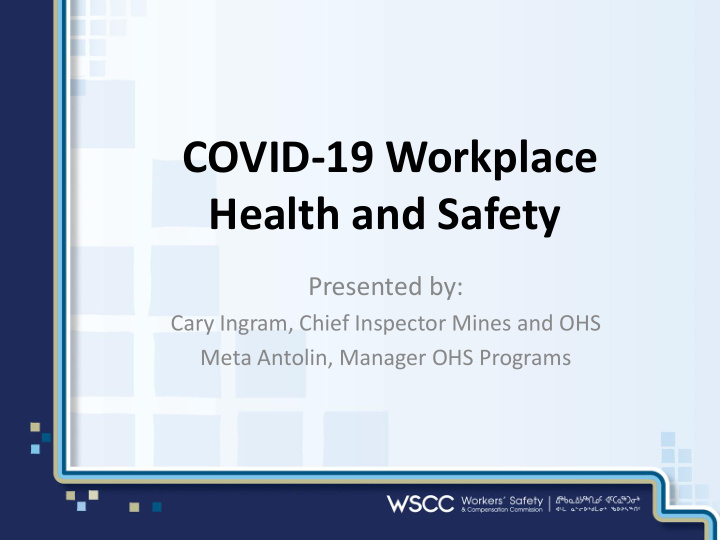



COVID-19 Workplace Health and Safety Presented by: Cary Ingram, Chief Inspector Mines and OHS Meta Antolin, Manager OHS Programs
Roles and Responsibilities • WSCC supports the direction provided by the CPHO • We continues to work with employers and workers to complete Exposure Control Plans • Inspectors will then conduct Inspections at workplaces
Reopening Safely As employers are allowed to resume business, they must have an Exposure Control Plan in place that: • looks at the risk of COVID-19 transmission in their workplace, and • outlines how employers and workers will manage that risk.
Why an Exposure Control Plan? Determine workers’ risk of exposure to the virus; Inform workers of their risk of exposure while at the worksite; and Outline how the employer will manage to eliminate or reduce those risks.
COVID-19 Risk Assessment and Worksite Precautions This is a tool for the employer, with workers, to: • identify the risks you need to eliminate or minimize, and • determine the steps you will take to protect Workers
Field Level Risk Assessment (FLRA) Workers complete the FLRA at the worksite. The assessment should • highlight specific areas where the worker can be exposed to COVID-19 virus at the site, and • Ensure that the controls identified in the Exposure Control Plan are in place before work begins.
Completed Risk Assessments You do not have to submit completed assessments to the WSCC. You will need to: 1. Keep the assessments at the worksite. 2. Update the information if conditions change. 3. Have the assessments available for WSCC or the Task force to review during worksite inspections.
COVID-19 Transmission Risks in the Workplace Person to Person transmission can happen because of : • Challenges maintaining 2 meters of distance • Different people in the workplace (such as, customers or clients) • The potential for group interaction • The chance of infected people being present • Self isolation practices not being followed properly Regular contact with shared surfaces increases likelihood of transmission.
Hierarchy of Controls
Hazard Control Hierarchy for COVID-19 1. Elimination Work from home, or stagger shifts. 2. Physical Distancing Keep at least 2 meters distance between everyone. 3. Engineering Controls Barriers at a check out, online ordering , phone or video conferencing, etc. 4. Administrative Controls Worker client health screening, enhanced cleaning procedures. 5. Personal Protective Equipment Disposable gloves, face shield, eye protection, etc. PPE is a last resort when physical distancing is not possible.
The Rights of Every Worker Regardless of employment status (full-time, part-time, temporary, etc.), all workers have 3 fundamental rights. • The Right to Know – training and education • The Right to Participate – taking part of your risk assessment and hazard control policy and procedure development. • The Right to Refuse unsafe work.
Remember… • The mental health of your workers is as important as their physical health. • Workers working from home have the same rights to a safe workplace. • WSCC’s continues to develop and update resources to follow the guidelines of NWT and NU health authorities orders. • It is important to stay informed.
WSCC is Available to Help • Email us at: COVID-19@wscc.nt.ca • Call us at: 1 (800) 661-0792 • WSCC has web pages with COVID-19 information and resources. • Follow us on Facebook and Twitter to see new resources as they are published.
Additional Resources • GNWT COVID-19 new website for up-to-date public health orders and public health information. • Canadian Centre for Occupational Health and Safety (CCOHS) online products and resources (webinars, posters, images)
If anyone at the worksite experiences symptoms • Immediately inform supervisor. • Physically distance from person and have them leave the workplace. • Seek medical advice from local Health Authority. For the NWT. • Call 911, if urgent care is required • Call 811 for the COVID-19 Hotline • If symptoms develop, schedule an appointment to be tested for COVID-19
Thank you Please contact us with any concerns regarding re-opening your business and maintaining safe operations. COVID-19@wscc.nt.ca
Recommend
More recommend